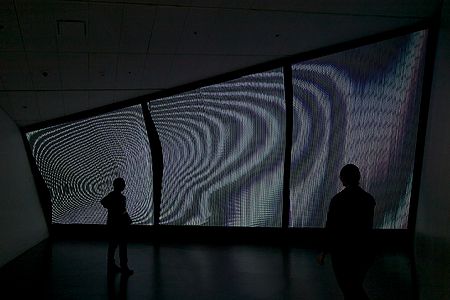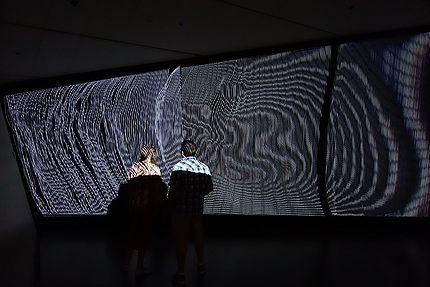Transposition

Artist: Cuppetelli and Mendoza
Date: 2013
Media: Interactive Installation
Transposition is an audiovisual, interactive, site-specific installation by Cuppetelli and Mendoza that explores the intersection between traditional craft and common materials and digital technology. [1] The work was first exhibited at the Denver Art Museum in May 2013. This work builds upon their previous work, Notional Field, by adding an interactive sound component to the piece. [2]
Formal Analysis and Technical Components
Video meets material in Cuppetelli and Mendoza's work. Tranposition is an installation that consists of a wall mounted with 348 elastic cord lines that are illuminated by a video projection of the same number of white lines generated through a custom software program. The piece is also accompanied by a music component by the artist Peter Segerstrom. The viewers that approach the work “activate” it. With their physical movement they affect the sound component and the projected lines. Moiré patterns are formed through the interface of the projection and the physical structure. [2] The direction and strength of the line’s movement as well as the change in sound is affected by the viewer’s motion that is registered by a video camera that feeds its image to the computer. [3]
Subject Matter and Interactivity
Most of the works by Cuppetelli and Mendoza focus in space as their main subject matter. [4] But they approach the concept of space in many different ways and the ideas of interface and interactivity are key to explore the spaces they offer. There is a clear interaction between the viewer and the piece: the viewer moves, the piece responds to that movement. Nevertheless, this interface of human/computer is not the only one present in Transposition. There is an interaction between the real and the virtual (the physical structure that are the cord lines and its relationship with the projected structure); between the foreground and the background (as the projection interferes with its shadow). [3]
Cuppetelli states that, in general for all of their collaborative work, they explore the space between the real and the virtual; between what exists and what is ignored; between the sensual and the logical; between our bodies and the physical structures that surround us. [4]
Transposition in particular stands out from the other collaborative works because it attempts to close the gap that is created by the experience of “disembodied embodiment” that occurs when the physical movements of the viewer are translated into virtual forces that affect the computer-generated lines and the sound component but without any sort of touch involved in this process. The music component was added to the piece with this purpose, to close the perceptual gap between body motion and reaction. [2]
The piece actually needs the audience to work, it needs someone to activate it, it needs movement it can respond to and therefore Transposition is only complete when a viewer interacts with it, making interactivity an essential part of the work.

Title Transposition
Artist Cuppetelli and Mendoza
Date 2013
Medium Interactive Installation

Title Transposition
Artist Cuppetelli and Mendoza
Date 2013
Medium Interactive Installation
References
- ↑ 'Cuppetelli & Mendoza: Transposition' http://www.denverartmuseum.org/exhibitions/transposition
- ↑ 2.0 2.1 2.2 'Transposition' http://cuppetellimendoza.com/transposition/
- ↑ 3.0 3.1 'Threaded Interface: Annica Cuppetelli and Cristobal Mendoza' http://www.grizzlygrizzly.com/_2012_shows/0412_ThreadedInterface.html
- ↑ 4.0 4.1 'Annica Leah Cuppetelli' http://annicacuppetelli.com/home.html
Wiki Authors
- Elizabeth Villalva (2014)